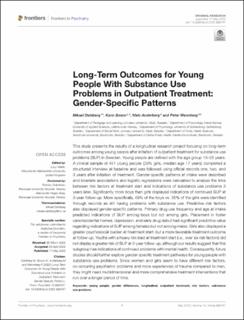| dc.contributor.author | Dahlberg, Mikael | |
| dc.contributor.author | Boson, Karin Margareta Mellberg | |
| dc.contributor.author | Anderberg, Mats | |
| dc.contributor.author | Wennberg, Peter | |
| dc.date.accessioned | 2022-11-08T08:44:48Z | |
| dc.date.available | 2022-11-08T08:44:48Z | |
| dc.date.created | 2022-05-18T09:04:42Z | |
| dc.date.issued | 2022 | |
| dc.identifier.issn | 1664-0640 | |
| dc.identifier.uri | https://hdl.handle.net/11250/3030558 | |
| dc.description.abstract | This study presents the results of a longitudinal research project focusing on long-term outcomes among young people after initiation of outpatient treatment for substance use problems (SUP) in Sweden. Young people are defined with the age group 13–25 years. A clinical sample of 451 young people (29% girls, median age 17 years) completed a structured interview at baseline and was followed using official records one, two, and 3 years after initiation of treatment. Gender-specific patterns at intake were described and bivariate associations and logistic regressions were calculated to analyse the links between risk factors at treatment start and indications of substance use problems 3 years later. Significantly more boys than girls displayed indications of continued SUP at 3-year follow-up. More specifically, 49% of the boys vs. 35% of the girls were identified through records as still having problems with substance use. Predictive risk factors also displayed gender-specific patterns. Primary drug use frequency and age at intake predicted indications of SUP among boys but not among girls. Placement in foster care/residential homes, depression, and early drug debut had significant predictive value regarding indications of SUP among females but not among males. Girls also displayed a greater psychosocial burden at treatment start, but a more favourable treatment outcome at follow-up. Youths with a heavy risk load at treatment start (i.e., over six risk factors) did not display a greater risk of SUP at 3-year follow-up, although our results suggest that this subgroup has indications of continued problems with mental health. Consequently, future studies should further explore gender-specific treatment pathways for young people with substance use problems. Since women and girls seem to have different risk factors, co-occurring psychiatric problems and more experiences of trauma compared to men, they might need multidimensional and more comprehensive treatment interventions that run over a longer period. | en_US |
| dc.language.iso | eng | en_US |
| dc.rights | Navngivelse 4.0 Internasjonal | * |
| dc.rights.uri | http://creativecommons.org/licenses/by/4.0/deed.no | * |
| dc.subject | young people | en_US |
| dc.subject | gender differences | en_US |
| dc.subject | longitudinal | en_US |
| dc.subject | outpatient treatment | en_US |
| dc.subject | risk factors | en_US |
| dc.subject | substance use problems | en_US |
| dc.title | Long-Term Outcomes for Young People With Substance Use Problems in Outpatient Treatment: Gender-Specific Patterns | en_US |
| dc.type | Peer reviewed | en_US |
| dc.type | Journal article | en_US |
| dc.description.version | publishedVersion | en_US |
| dc.subject.nsi | VDP::Samfunnsvitenskap: 200 | en_US |
| dc.source.volume | 13 | en_US |
| dc.source.journal | Frontiers in Psychiatry | en_US |
| dc.identifier.doi | 10.3389/fpsyt.2022.888197 | |
| dc.identifier.cristin | 2025031 | |
| dc.source.articlenumber | 888197 | en_US |
| cristin.ispublished | true | |
| cristin.fulltext | original | |
| cristin.qualitycode | 1 | |

